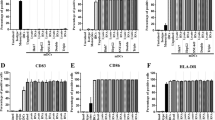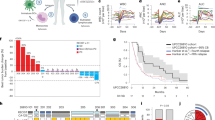Abstract
Uterine serous papillary carcinoma is a highly aggressive variant of endometrial cancer histologically similar to high grade ovarian cancer. Unlike ovarian cancer, however, it is a chemoresistant disease from onset, with responses to combined cisplatinum-based chemotherapy in the order of 20% and an extremely poor prognosis. In this study, we demonstrate that tumour lysate-pulsed autologous dendritic cells can elicit a specific CD8+ cytotoxic T lymphocyte response against autologous tumour target cells in three patients with uterine serous papillary cancer. CTL from patients 1 and 2 expressed strong cytolytic activity against autologous tumour cells, did not lyse autologous lymphoblasts or autologous EBV-transformed cell lines, and were variably cytotoxic against the NK-sensitive cell line K-562. Patient 3 CD8+ T cells expressed a modest but reproducible cytotoxicity against autologous tumour cells only at the time of the first priming. Further priming attempts with PBL collected from patient 3 after tumour progression in the lumboaortic lymph nodes were unsuccesful. Cytotoxicity against autologous tumour cells could be significantly inhibited by anti-HLA class I (W6/32) and anti-LFA-1 MAbs. Highly cytotoxic CD8+ T cells from patients 1 and 2 showed a heterogeneous CD56 expression while CD56 was not expressed by non-cytotoxic CD8+ T cells from patient 3. Using two colour flow cytometric analysis of intracellular cytokine expression at the single cell level, a striking dominance of IFN-γ expressors was detectable in CTL populations of patients 1 and 2 while in patient 3 a dominant population of CD8+ T cells expressing IL-4 and IL-10 was consistently detected. Taken together, these data demonstrate that tumour lysate-pulsed DC can be an effective tool in inducing uterine serous papillary cancer-specific CD8+ CTL able to kill autologous tumour cells in vitro. However, high levels of tumour specific tolerance in some patients may impose a significant barrier to therapeutic vaccination. These results may have important implications for the treatment in the adjuvant setting of uterine serous papillary cancer patients with active or adoptive immunotherapy.
This is a preview of subscription content, access via your institution
Access options
Subscribe to this journal
Receive 24 print issues and online access
$259.00 per year
only $10.79 per issue
Buy this article
- Purchase on Springer Link
- Instant access to full article PDF
Prices may be subject to local taxes which are calculated during checkout




Similar content being viewed by others
References
Boczkowski D, Nair SK, Snyder D, Gilboa E (1996) Dendritic cells pulsed with RNA are potent antigen presenting in vitro and in vivo. J Exp Med 184: 465–472
Carcangiu ML, Chambers JT (1992) Uterine papillary serous carcinoma: a study on 108 cases with emphasis on prognostic significance of associated endometrioid carcinoma, absence of invasion, and concomitant ovarian cancer. Gynecol Oncol 47: 298–305
Carcangiu ML, Chambers JT (1995) Early pathologic stage clear cell carcinoma and uterine papillary serous carcinoma of the endometrium, comparison of clinicopathological features and survival. Int J Gynecol Pathol 14: 30–38
Castelli C, Storkus WJ, Maeurer MJ, Martin DM, Huang EC, Pramanik BN, Nagabhushan TL, Parmiani G, Lotze MT (1996) Mass spectrometric identification of a naturally processed melanoma peptide recognized by CD8+ T cells. J Exp Med 181: 363–368
Coffman RL, Mocci S, O'Garra A (1999) The stability and reversibility of Th1 and Th2 populations. Curr Topics in Microbiol and Immunol 238: 1–12
Cox AL, Skipper J, Chen Y, Henderson RA, Darrow TL, Shabanowitz J, Engelhard VH, Hunt DF, Slingluff CL (1994) Identification of a peptide recognized by five melanoma-specific human cytotoxic T cell lines. Science 264: 716–719
Ghosh P, Komschlies KL, Cippitelli M, Longo DL, Subleski J, Ye J, Sica A, Young HA, Wiltrout RH, Ochoa AC (1995) Gradual loss of T-helper 1 populations in spleen of mice during progressive tumor growth. J Natl Cancer Inst 87: 1478–1483
Goff BA, Kato D, Schmidt RA, Ek M, Ferry JA, Muntz HG, Cain JM, Tamimi HK, Figge DC, Greer BE (1994) Uterine papillary serous carcinoma: Pattern of metastatic spread. Gynecol Oncol 54: 264–268
Hilders CGJM, Ras L, Van Eendenburg JDH, Nooyen Y, Fleuren GJ (1994) Isolation and characterization of tumor-infiltrating lymphocytes from cervical carcinoma. Int J Cancer 57: 805–813
Hopkins KA (1990) Basic microlymphocytotoxicity test. In ASHI laboratory manual pp 195–201, Lenexa (KS): American Society for Histocompatibility and Immunogenetics
Joannides CG, Fisk B, Pollack M, Frazier ML, Wharton JT, Freedman RS (1993) Cytotoxic T cell clones isolated from ovarian tumor infiltrating lymphocytes recognize common determinants on allogeneic tumors: implications for identification of TIL defined Ag on tumors. Scand J Immunol 37: 413–424
Levenback C, Burke TW, Silva E, Morris M, Gershenson DM, Kavanagh JJ, Wharton JT (1992) Uterine papillary serous carcinoma (USPC) treated with cisplatin, doxorubicin, and cyclophosphamide (PAC). Gynecol Oncol 46: 317–321
Nair SK, Boczkowski D, Snyder D, Gilboa E (1997a) Antigen-presenting cells pulsed with unfractionated tumor-derived peptides are potent tumor vaccines. Eur J Immunol 27: 589–597
Nair SK, Snyder D, Rouse BT, Gilboa E (1997b) Regression of tumors in mice vaccinated with professional antigen-presenting cells pulsed with tumor extracts. Int J Cancer 70: 706–715
Nazaruk RA, Rochford R, Hobbs MV, Cannon MJ (1998) Functional diversity of the CD8+ T cell response to Epstein-Barr virus (EBV). Implications for the pathogenesis of EBV-associated lymphoproliferative disorders. Blood 91: 3875–3883
Nicklin JL, Copeland LJ (1996) Endometrial papillary serous carcinoma: pattern of spread and treatment. Clin Obstet Gynecol 39: 686–695
Openshaw PJM, Murphy EE, Hosken NA, Maino V, Davis K, Murphy K, O'Garra A (1995) Heterogeneity of intracellular cytokine synthesis at the single cell level in polarized T helper 1 and T helper 2 populations. J Exp Med 182: 1357–1364
Peoples GE, Goedegeboure PS, Smith R, Linehan DC, Yoshino I, Eberlein TJ (1995) Breast and ovarian-cancer specific cytotoxic T lymphocytes recognize the same HER/2neu-derived peptide. Proc Natl Acad Sci USA 92: 432–436
Pittet MJ, Speiser DE, Valmori D, Cerottini J-C, Romero P (2000) Cytolytic effector function in human circulating CD8+ T cells closely correlated with CD56 surface expression. J Immunol 164: 1148–1152
Romagnani S (1992) Human TH1 and TH2 subsets: regulation of differentiation and role in protection and immunopathology. Int Arch Allergy Immunol 98: 279–285
Romani N, Gruner S, Brang D, Kampgen E, Lenz A, Trockebacher B, Konwalinka GO, Fritsch P, Steinman RM, Schuler G (1994) Proliferating dendritic cell progenitors in human blood. J Exp Med 180: 83–93
Sallusto F, Lanzavecchia A (1994) Efficient presentation of soluble antigen by cultured human dendritic cells is maintained by granulocyte/macrophage colony stimulating factor plus interleukin-4 and downregulated by tumor necrosis factor α. J Exp Med 179: 1109–1116
Santin AD, Rose GS, Hiserodt JC, Fruehauf J, Eck LM, Garcia RI, Schranz V, DiSaia PJ, Pecorelli S, Granger GA (1996) Effects of tumor necrosis factor-alfa plus interferon-gamma combined with high dose gamma irradiation on the expression of major histocompatibility complex molecules and intercellular adhesion molecule-1 in human ovarian cancers. Int J Cancer 65: 688–694
Santin AD, Hermonat Pl, Ravaggi A, Chiriva-Internati M, Zhan D, Pecorelli S, Parham GP, Cannon M (1999a) Induction of human papillomavirus-specific CD4+ and CD8+ lymphocytes by E7 pulsed autologous dendritic cells in patients with HPV16 and 18 positive cervical cancer. J Virol 73: 5402–5410
Santin AD, Hermonat PL, Ravaggi A, Chiriva-Internati M, Cannon MJ, Hiserod JC, Pecorelli S, Parham GP (1999b) Expression of surface antigens during the differentiation of human dendritic cells vs macrophages from blood monocytes in vitro. Immunobiol 200: 187–204
Santin AD (2000) Lymph node metastases; the importance of the micro-environment. (Editorial) Cancer 88: 174–178
Sherman ME, Bitterman P, Rosenshein NB, Delgado G, Kurman RJ (1992) Uterine serous carcinoma. A morphologically diverse neoplasm with unifying clinicopathological features. Am J Surg Pathol 16: 600–610
Steinman RM (1991) The dendritic cell system and its role in immunogenicity. Ann Rev Immunol 9: 271–296
Tsukui T, Hildesheim A, Schiffman MH, Lucci III J, Contois D, Lawler P, Rush BB, Loricz AT, Corrigan A, Burk RD, Qu W, Marshall MA, Mann D, Carrington M, Clerici M, Shearer GM, Carbone DP, Scott DR, Houghten RA, Berzofsky JA (1996) Interleukin 2 production in vitro by peripheral lymphocytes in response to human papillomavirus-derived peptides: correlation with cervical pathology. Cancer Res 56: 3967–3974
Yoshino I, Goedegeboure PS, Peoples GE, Parikh AS, DiMain JM, Lyerly HK, Gazdar AF, Eberlein TJ (1994) HER2/neu-derived peptides are shared antigens among human non-small cell lung cancer and ovarian cancer. Cancer Res 54: 3387–3390
Young JW, Inaba K (1996) Dendritic cells as adjuvants for class I major histocompatibility complex-restricted antitumor immunity. J Exp Med 183: 7–11
Zitvogel L, Majordomo JI, Tjandrawan T, DeLeo AB, Clarke MR, Lotze MT, Storkus WJ (1996) Therapy of murine tumors with tumor peptide-pulsed dendritic cells:dependence on T cells, B7 costimulation, and T helper cell 1-associated cytokines. J Exp Med 183: 87–97
Acknowledgements
This work was supported in part by grants from the Camillo Golgi foundation, Brescia, Italy, the Lega Nazionale contro i Tumori Sezione di Brescia and NIH grant CA63931 to MJ Cannon. The authors thank Donna Dunn, Cathy Buzbee and Janet Linam for their excellent technical support and assistance and Susan Young for HLA typing.
Author information
Authors and Affiliations
Corresponding author
Rights and permissions
About this article
Cite this article
Santin, A., Bellone, S., Ravaggi, A. et al. Induction of tumour-specific CD8+ cytotoxic T lymphocytes by tumour lysate-pulsed autologous dendritic cells in patients with uterine serous papillary cancer. Br J Cancer 86, 151–157 (2002). https://doi.org/10.1038/sj.bjc.6600026
Received:
Revised:
Accepted:
Published:
Issue Date:
DOI: https://doi.org/10.1038/sj.bjc.6600026
Keywords
This article is cited by
-
A novel method for efficient generation of antigen-specific effector T-cells using dendritic cells transduced with recombinant adeno-associated virus and p38 kinase blockade
Journal of Translational Medicine (2019)
-
Immunotherapy in endometrial cancer - an evolving therapeutic paradigm
Gynecologic Oncology Research and Practice (2015)
-
Combinational adenovirus-mediated gene therapy and dendritic cell vaccine in combating well-established tumors
Cell Research (2006)
-
Discrimination between uterine serous papillary carcinomas and ovarian serous papillary tumours by gene expression profiling
British Journal of Cancer (2004)
-
Leukemic dendritic cells: potential for therapy and insights towards immune escape by leukemic blasts
Leukemia (2002)



